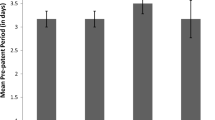Abstract
Blood and bone marrow eosinophilia was assessed in nonpermissive (guinea pigs) and permissive (rats) hosts following the pulmonary arterial transfers of live or dead young adult worms ofAngiostrongylus cantonensis. Guinea pigs showed a marked eosinophilic response to live worms but only a slight response to dead worms. Neither IgE nor haemagglutinating antibodies correlated with the induction of this eosinophilia. In contrast, the rat responded to neither form of the young adult worm. When the guinea pig and the rat were injected with whole worm extract (WWE) of the young adult worms either by an osmotic minipump connected to the jugular vein or by intermittent intravenous injections, the former animal showed blood eosinophilia but the latter failed to do so. Guinea pigs also developed blood eosinophilia after continuous exposure to the excretory and secretory products of the young adult worms, administered by the mini-pump. Eosinophil responses to WWE could be induced both in athymic CD-1 (ICR) nude mice and in its heterozygous litter mates, suggesting that T cell-independent mechanism(s) could be involved in the induction of blood eosinophilia in the nonpermissive, mouse host. These data clearly indicate that the eosinophilia-inducing factor(s) and the mechanism of eosinophilia are different in permissive and nonpermissive hosts.
Similar content being viewed by others
References
Alicata JE, Jindrak K (1970) Angiostronglosis in the Pacific and Southeast Asia Charles C Thomas, Springfield, Illinois
Basten A, Boyer MH, Beeson PB (1970) Mechanism of eosinophilia. I. Factors affecting the eosinophil response of rats toTrichinella spiralis. J. Exp Med 131:1271–1287
Doy TG, Hughes DL (1982) The role of the thymus in the eosinophil response of rats infected withFasciola hepatica. Clin Exp Immunol 47:74–76
Gustowska L, Ruitenberg EJ, Elgersma A (1980) Cellular reactions in tongue and gut in murine trichinellosis and their thymus-dependence. Parasite Immunol 2:133–154
Hudson G (1963) Changes in the marrow reserve of eosinophils following re-exposure to foreign protein. Br J Haematol 9:446–455
Kamiya M, Oku Y, Kamiya H, Nomura T (1982) Characteristic responses of nude mice in angiostrongyliasis and eoninococcosis. Proc Third Int Workshop on Nude Mice, Gustav Fischer, New York, p 133
Lowry OH, Rosebrough NJ, Farr AL, Randall RJ (1951) Protein measurements with the Folin phenol reagent. J Biol Chem 193:265–275
Pritchard DI, Eady RP (1981) Eosinophilia in athymic nude (rnu/rnu) rats — thymus independent eosinophilia? Immunology 43:409–416
Slungaard A, Ascensao J, Zanjani E, Jacob HS (1983) Pulmonary carcinoma with eosinephilia. Demonstration of a tumor-derived eosinophilopoietic factor. N Engl J Med 309:778–781
Spry CJF (1971) Mechanism of eosinophilia. VI. Eosinophil mobilization. Cell Tissue Kinet 4:365–374
Sugane K, Oshima T (1984) Induction of peripheral blood eosinophilia in mice by excretory and secretory antigen ofToxocara canis larvae. J Helminthol 58:143–147
Takenaka T, Okuda M, Kubo K, Uda H (1975) Studies on interrelations between eosinophilia, serum IgE and tissue mast cells. Clin Allergy 5:175–180
Tsuda S, Fukuyama K, Epstein WL (1980) Induction of T cell-independent eosinophilia in mice with polymyxin B and schistosome infection. Lab Invest 43:495–499
Vogel M (1947) The femoral bone marrow cells of the albino rat. Am J Med Sci 213:456–462
Walls RS, Beeson PB (1972) Mechanism of eosinophilia. VIII. Importance of local cellular reactions in stimulating eosinophil production. Clin Exp Immunol 12:111–119
Yoffey JM, Ancill RJ, Holt JAG, Owen-Smith B, Herdan G (1954) A quantitative study of the effects of compound E, compound F and compound A, upon the bone marrow of the guinea-pig. J Anat 88:115–130
Yoshimura K (1984) Eosinophilic responses and their functions in the neurotropic nematode,Angiostrongylus cantonensis, infection as seen in the animal models. In: Ko RC (ed) Current Perspectives in Parasitic Diseases. University of Hong Kong, Hong Kong, p 151
Yoshimura K, Soulsby EJL (1976)Angiostrongylus cantonensis: Lymphoid cell responsiveness and antibody production in rats. Am J Trop Med Hyg 25:99–107
Yoshimura K, Aiba H, Oya H (1979) Transplantation of young adultAngiostrongylus cantonensis into the rat pulmonary vessels and its application to the assessment of acquired resistance. Int J Parasitol 9:97–103
Yoshimura K, Aiba H, Oya H, Fukuda Y (1980)Angiostrongylus cantonensis: Development following pulmonary arterial transfers into permissive and nonpermissive hosts. Exp Parasitol 49:339–352
Yoshimura K, Uchida K, Sato K, Oya H (1984) Ultrastructural evidence for eosinophil-mediated destruction ofAngiostrongylus cantonensis transferred into the pulmonary artery of nonpermissive hosts. Parasite Immunol 6:105–118
Author information
Authors and Affiliations
Rights and permissions
About this article
Cite this article
Ishida, K., Yoshimura, K. Eosinophil responses of permissive and nonpermissive hosts to the young adult worms ofAngiostrongylus cantonensis . Z. Parasitenkd. 72, 661–671 (1986). https://doi.org/10.1007/BF00925488
Accepted:
Issue Date:
DOI: https://doi.org/10.1007/BF00925488




